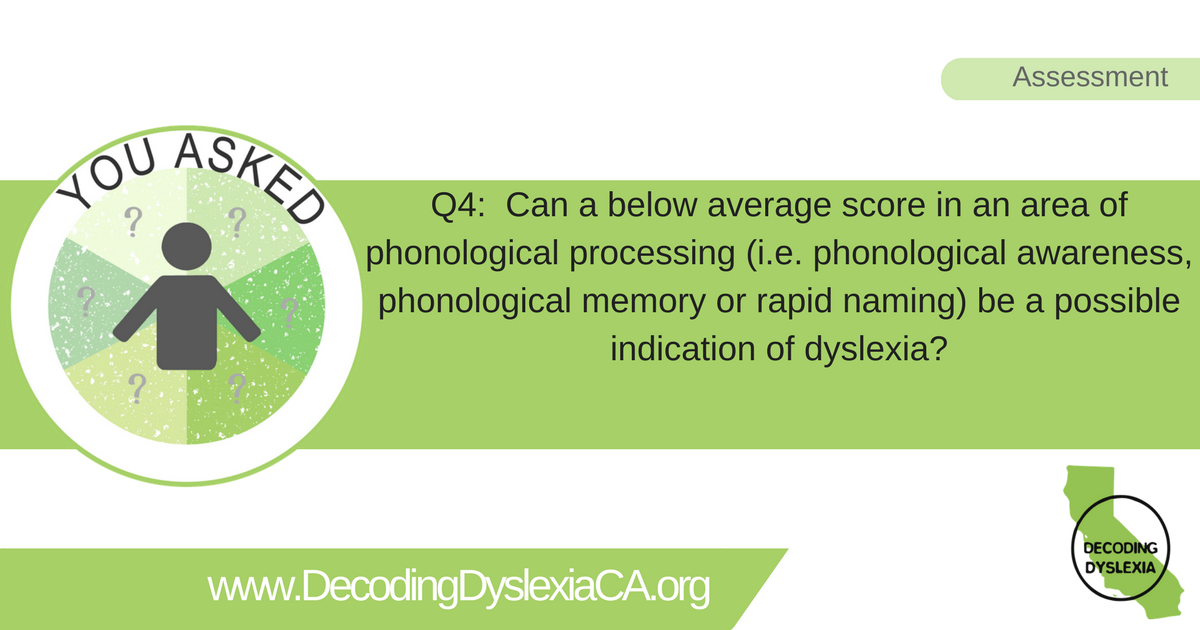Download a PDF version of this You Asked question and answer HERE.
Q22: Why are younger students generally not found eligible for Specific Learning Disability when a “severe discrepancy” model is used for special education eligibility?
A: Under California law, the use of severe discrepancy may be considered but must not be required [5 CCR 3030(b)(10)(B), 34 CFR 300.307(a)(1)]. Many school districts are by default requiring a severe discrepancy by not looking to other allowable methods in determining a specific learning disability for special education eligibility purposes. [Please refer to You Asked #23 for additional information].
In California, a severe discrepancy is defined as a difference between intellectual ability (“IQ) and achievement of 1.5 standard deviations (or more)*. For our younger students with suspected dyslexia that would mean a “severe discrepancy” in areas such as basic reading (or spelling) on standardized achievement testing.
For younger students (Kindergarten through 2nd grade), it would be very difficult to have this large of a gap between IQ and standardized academic achievement test scores in reading or spelling. The International Dyslexia Association (IDA) explains: “although there are many tests that may be used early (in Kindergarten and beginning of first grade) to assess beginning skills in reading and spelling, the standards for average achievement are generous. A child in late Kindergarten or early first grade may only need to read a few letters and two or three common words to score well enough to reach a score of “average”. Compared to other young learners, students with dyslexia may not seem to be “behind.” ” [Source: The International Dyslexia Association, “Just the Facts: Testing and Evaluation“].
IDA states that “research demonstrates that additional direct instruction provided appropriately, beginning in Kindergarten through third grade, can help all but the most severely impaired students catch up to grade-level literacy skills and close the gap for most poor readers. Assessment is the first step in identifying these students early to make sure they receive the effective instruction they need to succeed.” [Source: The International Dyslexia Association, “Just the Facts: Dyslexia Assessment: What Is It and How Can It Help?]
So, it is unlikely that a younger student will demonstrate a “severe discrepancy” on standardized achievement testing for the reasons given above but we also know that early identification and appropriate intensive intervention greatly increases the positive outcomes for our dyslexic students so what should be done with respect to our younger students?
Even before formal assessment, careful early screening of younger students beginning in Kindergarten can help identify students at risk for dyslexia. According to IDA, screening should occur in the following areas (before second grade), “it is more important to focus an evaluation on the precursors of reading development. Measures of language skills, phonological awareness, memory, and rapid naming are more suggestive of being at-risk for dyslexia among young children than are measures of word reading, decoding, and spelling. Therefore, measures of phonological awareness, memory, and rapid naming are typically included in Kindergarten and beginning first grade screening tests that can identify children who need targeted intervention to improve these critical skills so these children can meet grade-level benchmarks.” [Source: The International Dyslexia Association, “Just the Facts: Testing and Evaluation“].
For purposes of assessment, California regulations appear to acknowledge the difficulty in identifying a severe discrepancy especially in younger children and provide IEP teams with flexibility in applying these rules under 5 CCR 3030(b)(10)(B)(3) which provides for the following:
“If the standardized tests do not reveal a severe discrepancy as defined in subdivisions 1. or 2. above, the IEP team may find that a severe discrepancy does exist, provided that the team documents in a written report that the severe discrepancy between ability and achievement exists as a result of a disorder in one or more of the basic psychological processes. The report shall include a statement of the area, the degree, and the basis and method used in determining the discrepancy. The report shall contain information considered by the team which shall include, but not be limited to:
(i) Data obtained from standardized assessment instruments;
(ii) Information provided by the parent;
(iii) Information provided by the pupil’s present teacher;
(iv) Evidence of the pupil’s performance in the regular and/or special education classroom obtained from observations, work samples, and group test scores;
(v) Consideration of the pupil’s age, particularly for young children [emphasis added]; and
(vi) Any additional relevant information.”
* – Please be advised that in California, IQ testing of African-American students is prohibited [refer to Larry P. v. Riles, 495 F. Supp. 926 (N.D. Cal 1979), 793 F. 2d 969 (9th Cir. 1984), 37 F. 3d 485 (9th Cir. 1994). Also, see article from CA Association of School Psychologists (CASP Today Spring 2013 – Larry P. Edition, pgs. 7, 17)].
For more YOU ASKED questions and answers click HERE.


